13 Social Collaboration Tools That Improve Team Efficiency
There are plenty of different collaboration tools like Slack and Microsoft Teams, but we've found that improving collaboration efficiency isn't just about buying more social collaboration tools.
Instead, we've found that the best collaboration tools eliminate the need to send teammates messages. These tools enable teammates to track project progress asynchronously and access all the information they need inside the platform without sending any of their co-workers a message.
For example, if you're relying entirely on Slack for all of your social collaboration, you're probably sending some of these messages to colleagues:
-
Do you mind engaging with the post I just published on LinkedIn?
-
Can you give me a quote about your views on X so that I can publish a post on Twitter?
-
Can you remember to ping me when you're about to release that announcement so that I remember to promote it on social media?
-
Can you send me the images we made for that project?
While this kind of internal communication can work, it's not particularly efficient as you have to track down various Slack conversations, and it's very easy to forget key tasks.
So instead of just giving you a list of generic instant messaging platforms, the social media collaboration tools in this post help you automate key processes, reduce communication needs, and better organize the communication that does need to happen.
GaggleAMP – Best For Employee Advocacy
GaggleAMP is our own employee advocacy tool, and our founder built it because he believed that the best way to leverage social media and multiply brand awareness is by using the company's employees to engage organically with social media posts.
This way, the employees' social networks are organically introduced to the brand. In addition, social media algorithms view the engagement from employees as a positive user signal and often respond by giving the post even more organic reach.
However, there was one problem with employee advocacy.
Getting employees to consistently engage with the right posts can be a communication nightmare.
Mass Slack messages and emails are often ignored, but sending personalized messages to specific employees to share specific content doesn't scale.
To solve this problem, we created GaggleAMP so that you can assign specific engagement activities at scale and enable employees to schedule their engagement activities to go live at a future time/date.
This way, it only takes you about ten minutes to send personalized engagement requests to hundreds of employees, and it only takes employees about ten minutes to complete the engagement activities and schedule them to go live throughout the week/month.
Here's an overview of how it works.
Step 1: Select an Engagement Activity and Add Instructions
Rather than messaging employees and asking them to engage with specific posts, all you have to do is select one of GaggleAMP's many engagement activities.
From there, you give them the specific post you want them to engage with and key instructions (like pre-written text) that might be helpful for the employee.

Step 2: Assign an Engagement Activity
Once your engagement activity is ready, you can assign it to either a specific individual employee or a group of employees. This way, you always have the option to create an assignment for a specific person, but the group option also makes it easier to scale the assignment process.
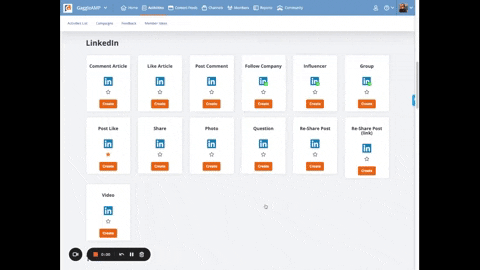
Step 3: Employees Receive a Notification and Log Into The Gaggle
Once you assign an engagement activity, employees receive a notification about it and they can hop into their personalized Gaggle to complete the assignments. If you tend to send assignments frequently, employees can customize the notifications so that they don't become noisy.
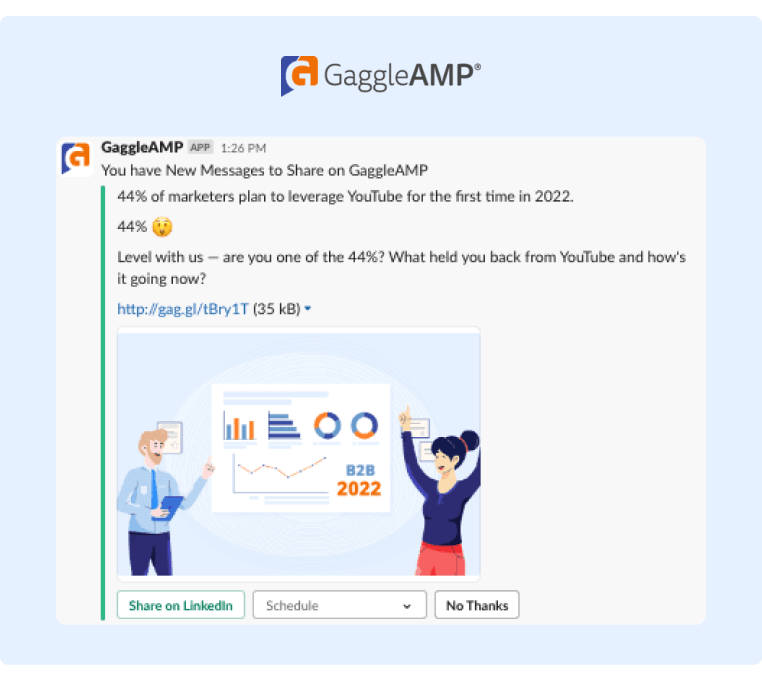 Example of a Gaggle Activity appearing as a Slack notification to complete the activity
Example of a Gaggle Activity appearing as a Slack notification to complete the activity
After clicking into their personalized Gaggle, employees will see a list of specific engagement activities assigned by the manager.
This structure is unique as most employee advocacy platforms just send the employee to a feed of the company's social media posts. From there, the employee has to select the post they want to engage with. This adds an additional friction point as employees might not know what they should share or say.
Selecting posts for employees may seem like a small difference, but it can significantly increase engagement rates. Employees don't feel overwhelmed when they log into the Gaggle as there are always a handful of posts with specific engagement instructions (like, comment, share, etc.) to complete.
Each post also has an expiration date (which you can specify when assigning the post). It will disappear from their Gaggle, even if it wasn't completed, once that expiration date passes to avoid overwhelming employees.
We're proud of GaggleAMP because we find that it removes friction for both you and your co-workers to engage on social media. To see for yourself if it is a good fit for your social media strategy, consider scheduling a demo today.
Step 4: Employees Complete The Engagement Activity and Schedule it To Publish
Once employees log into the platform, they can complete their engagement assignments directly inside the Gaggle. This is a major benefit as they rarely have to log into a social media account to complete the assignment.
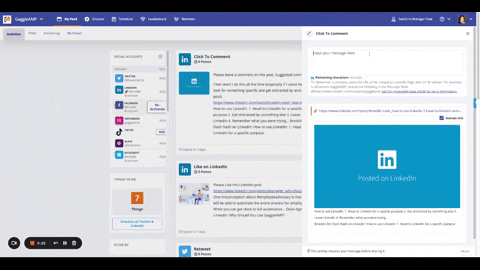
In addition, they can publish the post to go live at a future date/time directly inside the Gaggle. This way, they only have to spend a few minutes on employee advocacy once per week, and their engagements will go live throughout the week.
By removing as much friction as possible for employees to engage, GaggleAMP has helped plenty of companies dramatically increase employee engagement rates.
Step 5: Measure Employee Engagement and Campaign Performance
Finally, GaggleAMP also measures employee engagement and campaign performance.
The public Leaderboard is excellent for encouraging participation as it ranks employees by engagement. Specifically, you can assign points for each engagement task you assign (e.g., 5 points for a like, 10 points for a comment, 15 points for a share, etc.).
When employees complete the engagement activities, they receive the corresponding points, and the Leaderboard ranks employees by point totals. This inspires friendly competition and enables you to reward the most engaged employees.
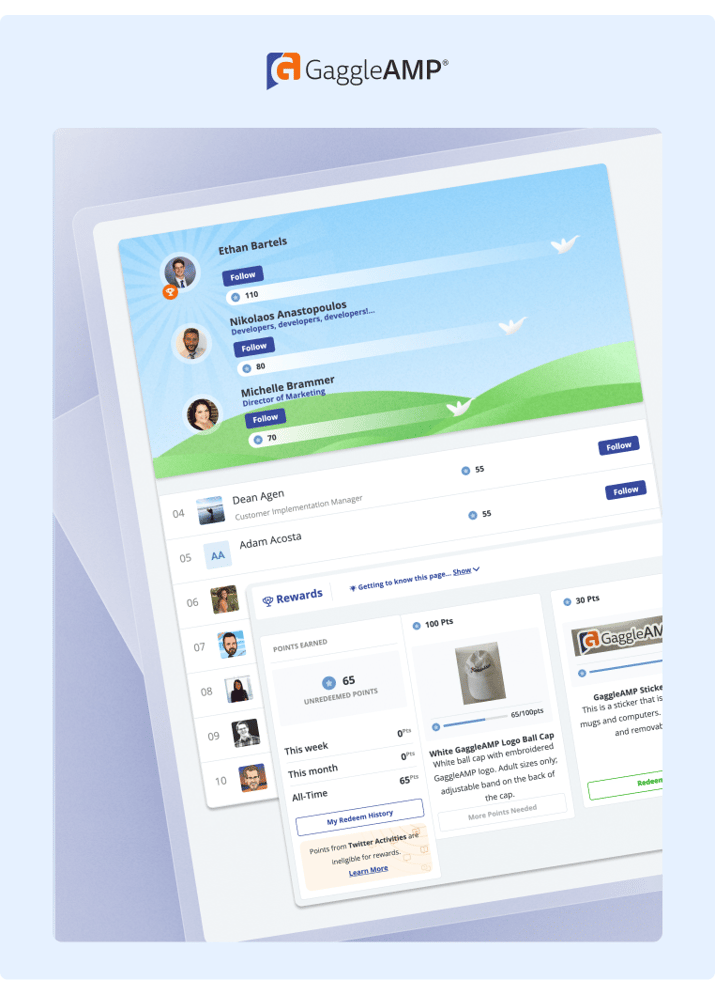
GaggleAMP also offers a robust analytics dashboard that shows you key statistics like estimated earned media value (EEMV), clicks, shares, and reach of campaigns.
You can filter data from different social media channels and see which ones are most effective to better optimize future campaigns.
To see for yourself if GaggleAMP can improve team communication, schedule a demo today.
How Does GaggleAMP Streamline Team Collaboration?
The very best social collaboration tools eliminate the need for communication (such as email and Slack messages) altogether.
GaggleAMP is, therefore, the poster child of an efficient team collaboration platform.
If you're trying to do employee advocacy without GaggleAMP, you're probably sending many Slack and/or email messages with engagement requests. In addition, you can't specify which employees should share what posts, and there isn't any way to measure your efforts.
GaggleAMP streamlines collaboration by enabling you to assign specific engagement activities to specific employees (at scale) in a matter of minutes.
In addition, employees don't have the burden of:
- choosing a post
- deciding how to engage
- posting daily
Instead, they just log into their Gaggle once per week, see a handful of pre-selected posts with specific engagement activities, and they can schedule them to go live throughout the week leveraging the usage of an intuitive content calendar to help them streamline their social media posts.
As you can see, GaggleAMP drastically reduces the time marketing managers spend sending messages and it also saves employees from sending follow-up clarification questions.
If you want to see how you can leverage GaggleAMP to improve team collaboration and boost your employee advocacy strategy, schedule a demo today.
Best For Scheduling Posts
Most social media posts aren’t created by a single person. For example, you might have a graphic designer, a blog post writer, or an internal executive providing quotes.
Here we’ll introduce you to a handful of social media tools that make it easier for you to delegate tasks and improve your social media workflow.
Social Pilot
Social Pilot makes it easy for you to schedule posts and delegate tasks to other team members.
Here's how you can use Social Pilot's collaboration software:
-
Assign roles and permissions: You can grant various access levels such as admin, manager, and content creator so that people can upload their tasks directly to the platform.
-
Create an efficient workflow process: Content creators can submit content to be published, and managers can approve it before it goes live.
-
Always have access to new content: Social Pilot's content feeds makes it easy to always find new content to repurpose and post. This way, you don't have to ask other team members for the most recent blog posts or webinar content – it's already in Social Pilot.
-
The Social Calendar keeps the team aligned: When team members can see your social calendar, they're much less likely to send you messages like "when will this post go live?"
Social Pilot also provides detailed analytics and reporting so that your direct reports can monitor progress without asking you for updates.
Pricing
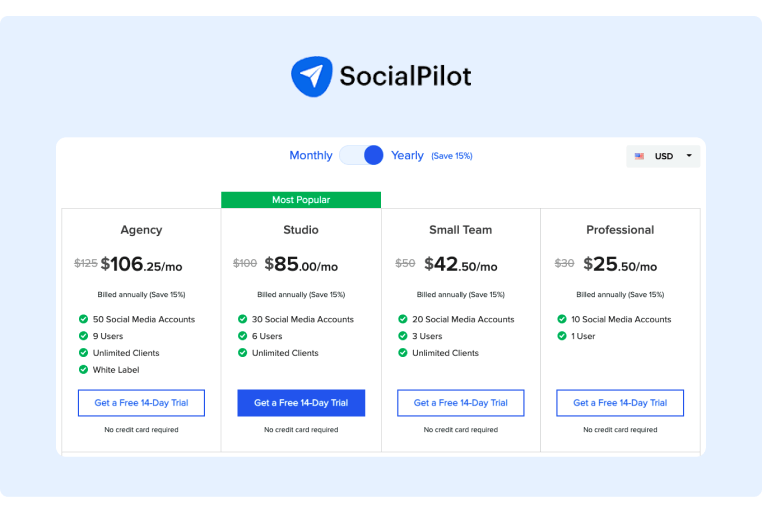
Vista Social
Vista Social is another social media and task management platform that has gained popularity in the past several years.
It offers all of the following features:
- Publishing collaboration: You can schedule posts to go live with the content calendar and use the approval workflow to enable other team members (like content creators) to create posts so that you can just approve them before they go live. It also offers media integrations so that your team doesn't have to search for videos.
- Respond to engagement from one platform: You can monitor engagement and respond to comments from one dashboard. You can also create internal notes for other team members or even delegate specific tasks (like responding to comments) to co-workers.
- Analytics dashboard: The analytics dashboard lets you create reports and send them to executives or stakeholders.
- Social listening: You can track your competitors and share key information with the rest of the team.
- Review management: Instead of hiring an intern to search across the internet for reviews and mentions of your brand, Vista Social makes it possible to do so from one dashboard.
If you're looking for a basic social media marketing platform with good team collaboration options, you might consider Vista Social. Reviewers also say that they have a responsive support team that's easy to work with.
Pricing
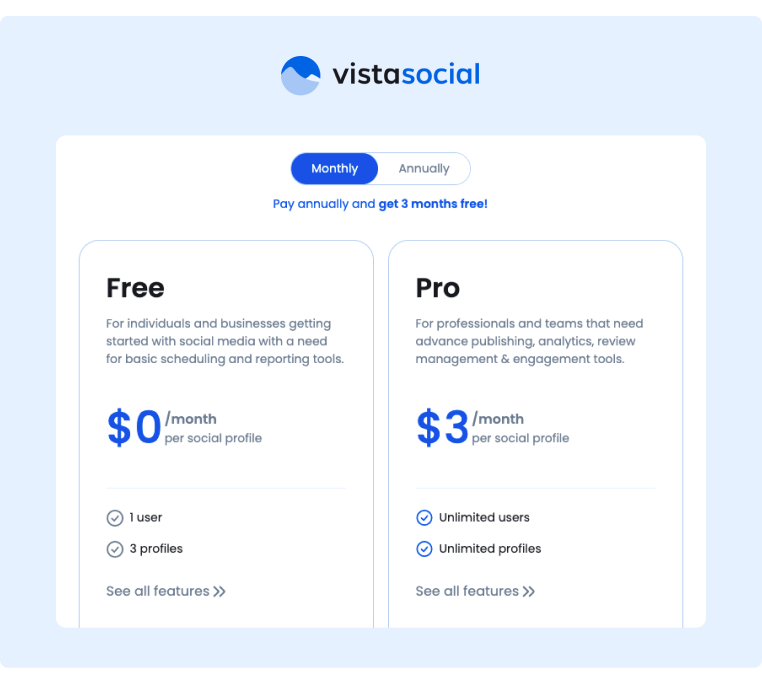
Planable
Planable is another social scheduling tool that makes collaboration easier for your marketing team. Here's an overview of the main features they promote:
- Create and schedule social media posts: You can create and schedule all of your posts to go live on various social media platforms (natively) from one dashboard.
- Visual content calendar: The content calendar provides a mini-image of the scheduled post for the whole team to see.
- Invite collaborators with different permission levels: You can have content creators upload content directly to the platform.
- Comment in context: When a post is uploaded, the team can comment on the post and add internal notes.
- Media storage: Rather than digging through Dropbox images, Planable stores media directly inside the platform to make it easier for you to pull content.
Planable also offers approval workflows and notifies team members when posts are submitted and/or approved.
Pricing
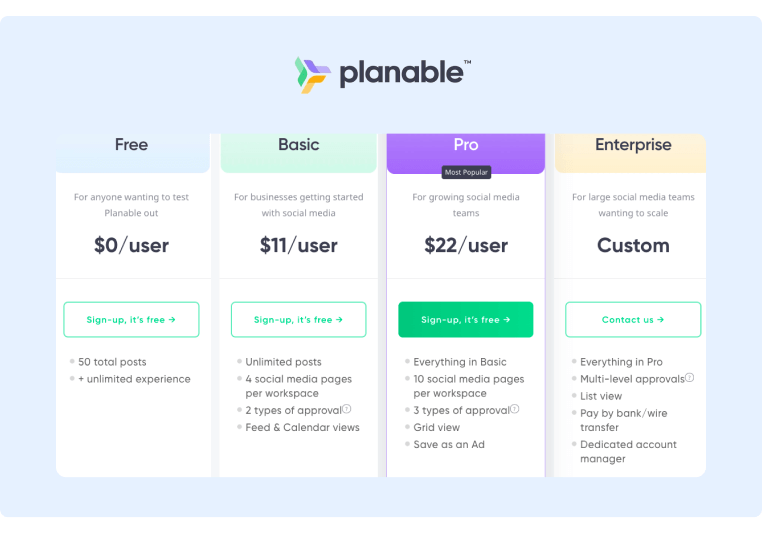
Best For File Storage
"Can you send me that image?"
If you don't have an effective file-sharing tool, you're probably sending and receiving a lot of messages like the one above. It's annoying for the person that has to dig out the media and send it, and it's equally annoying for the person that needs the media and is otherwise ready to publish the post.
That's the problem these file-sharing solutions solve.
Dropbox
Dropbox is one of the most popular tools to share files, media, and other content across teams, with real-time collaboration features like team commenting, @mentioning team members, and assigning specific tasks.
It enables users to sync and store content across multiple platforms and devices so that even if you save the media on your computer, you can still access it later on your mobile device.
Dropbox also does automatic backups to ensure you don't lose your files. Even if you accidentally deleted something or changed it too early, earlier versions of your files are backed up for at least 30 days (and 180 days for Dropbox Business users).
If you have sensitive data, you can also leverage Dropbox's file permissions, such as view-only, comment-only, and editor.
Pricing
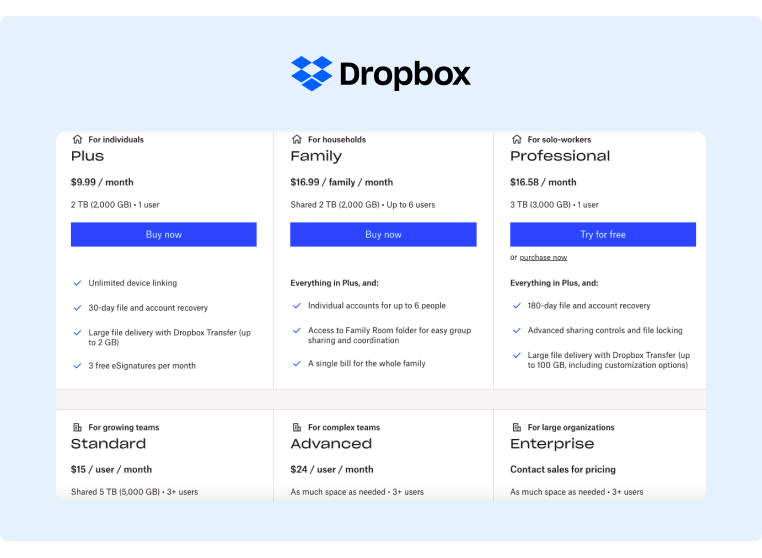
Google Drive
If you're looking for a solution that's similar to Dropbox, but mostly free, Google Drive is another popular file management tool.
Within Google Drive, you can create and store media and other documents. It also offers basic permissions like view, comment, and editor access so that you can collaborate in context.
Another benefit of Google Drive is that it seamlessly connects with other Google products like Google Docs, Forms, Sheets, and more so that you can easily access other materials you might need for your post.
Google Drive also enables you to access your files on any device (desktop, mobile, tablet, etc.).
However, a major drawback is that Google Drive does not automatically back up files for you. Similarly, if your Google account is banned or deleted, you won't be able to retrieve your files.
Pricing
Google Drive does not offer any clear pricing information. While it offers a generous free plan, you might have to upgrade if you exceed the free storage space.
Filecamp
Filecamp also offers basic file storage functionalities, including secure file storage and team collaboration permissions (view, comment, edit).
However, it also advertises several other features that aren't found in other solutions like Dropbox and Google Drive, including:
- Keywords/tags (to easily find and organize materials)
- White label/custom branding
- Branding guidelines
- Custom terms and conditions
A drawback of Filecamp is that it currently does not offer a mobile app, though it does have a mobile responsive UI.
If you're a larger team looking for a Dropbox alternative, Filecamp might be a good option as it charges a flat rate per company rather than charging per user.
Pricing
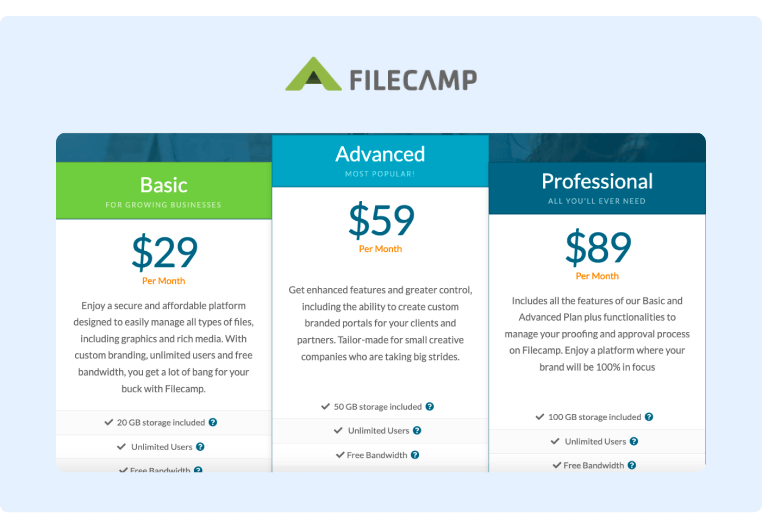
Best For Project Management
You can significantly improve workflow efficiency by implementing project management software that your team loves using daily. This makes it easy for everyone on the team to stay aligned on deadlines and project progress without sending endless messages.
Here are a few of our favorite project management solutions.
Trello
Trello is a popular project management platform among freelancers and small businesses, thanks to its beautiful and simple user interface.
The default interface is a Kanban board that lets users create projects and move them to other boards as the project progresses.
For example, you might have a multi-step publishing process, including post ideation, content writing, graphic design, and approval. So you could create a board for each of those four steps, add the relevant people (content writer, graphic designer, etc.), and add due dates for each step of the process. With this visual structure, each person knows exactly how the project is progressing so that it's completed on time.
The calendar view also makes it easy to see a 30,000 foot view of the team's productivity and the month's plan.
Despite its simplicity, Trello offers substantial access settings as you can add members (at different permission settings) to specific boards, projects, and workspaces.
If it's your first time setting up a project, you can use one of Trello's templates to help you get started.
Pricing
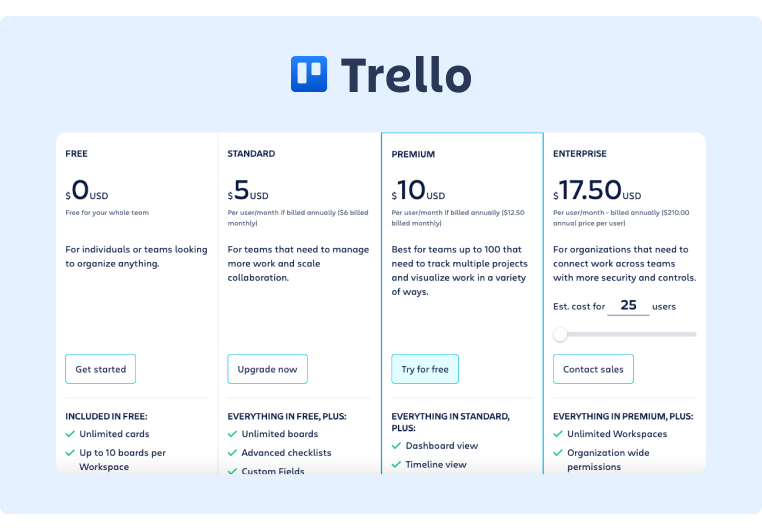
Asana
Asana is typically considered a step up from Trello as it's designed more for larger teams and offers various workflows like campaign management, creative production, agile management, and more.
Like most standard project management software, Asana offers advanced user permissions and enables the team to collaborate asynchronously with due dates and project statuses. If you need to message a team member, Asana also offers internal team messaging.
In addition to basic project communication, Asana also offers campaign analytics like project status and team progress.
You can also use Asana's automation features to create rules for repetitive tasks or leverage custom templates for standard workflows, like user onboarding.
Finally, if Asana is missing something, you can use one of its integrations to get the data you need and incorporate it into other tools like Slack.
Pricing
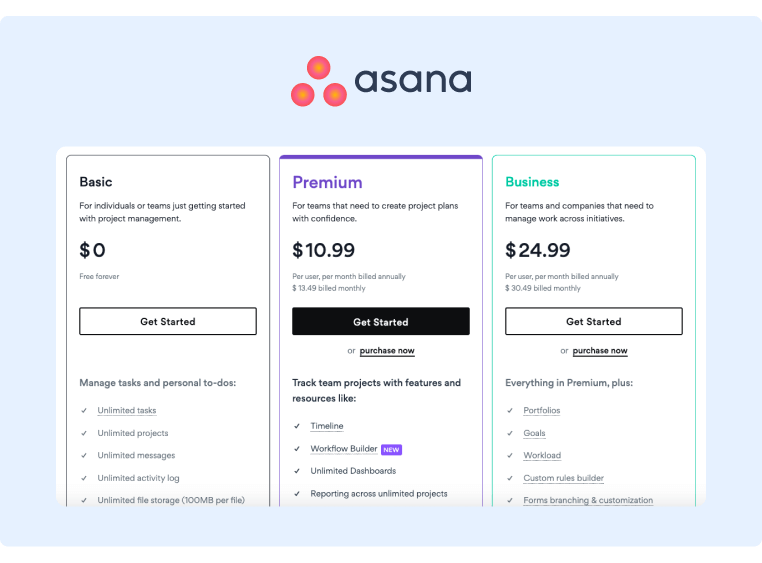
Teamwork
Teamwork is another project management tool built specifically for service businesses, like agencies, that deal with clients.
A few of the features it offers that make it ideal for service businesses include:
- Extensive team permissions to accommodate freelancers, contractors, and clients.
- Advanced time tracking features to track billable hours and properly allocate resources.
- Plenty of scalability options like adding a CRM, desk, or chat, to your set-up
Teamwork also offers a super simple user interface that makes it easy for everyone to know what the rest of the team is working on and gauge progress without ever sending a message.
However, if you need to ask a question, you can comment directly on tasks so that all communication is directly inside that project.
If Teamwork is missing a tool you need, you can always leverage its integrations to add on a third-party tool.
Pricing
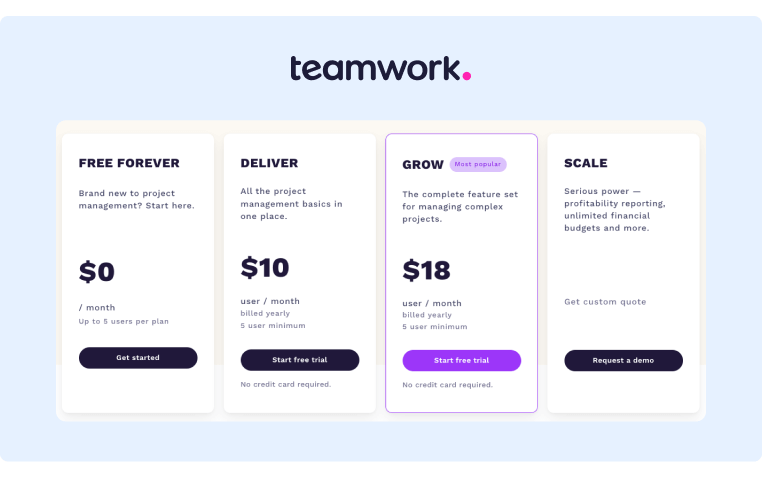
Best For Daily Communication
All of the tools mentioned above are designed to eliminate the need for communication, but there will always be a few questions that require traditional messaging. So here are the two most popular messaging tools to streamline your communication.
Slack
Slack is perhaps the most popular communication tool available, and its main purpose is to speed up the time it takes for people to respond via email. So instead of writing out a formal email and then waiting a day for a response, you can cut the message in half and get a response in minutes.
Slack is easy to use, and the interface is pretty straightforward, making onboarding simple.
You can organize threads for conversations that concern specific groups of people, or you can directly message any individual person.
Even if you're working with contractors, you can add them to the Slack channel to speed up communication and get your work done faster.
Slack also offers customizable notifications (e.g., only notify employees during certain hours), and employees can also post their status, such as "on vacation" or "in a meeting."
Pricing
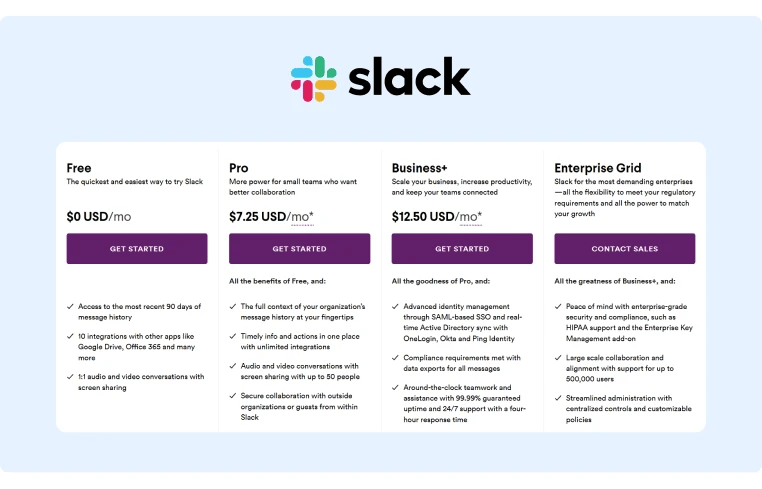
Microsoft Teams
Microsoft Teams is a Slack alternative that offers most of the same features and is ideal for businesses already using Office 365 Business as Teams is included in the plan. This is probably why Microsoft Teams actually has more users than Slack at this time.
Diving into the tool itself, you can chat with your colleagues, create threads, share files, and more. It also allows users to host video conferencing and screen share directly inside the platform. However, it doesn't offer quite the same user experience with a slightly more complex user interface and fewer advanced features.
Nevertheless, Microsoft Teams does offer a competitive product with extensive integrations, compliance, and bots/workflows.
Pricing
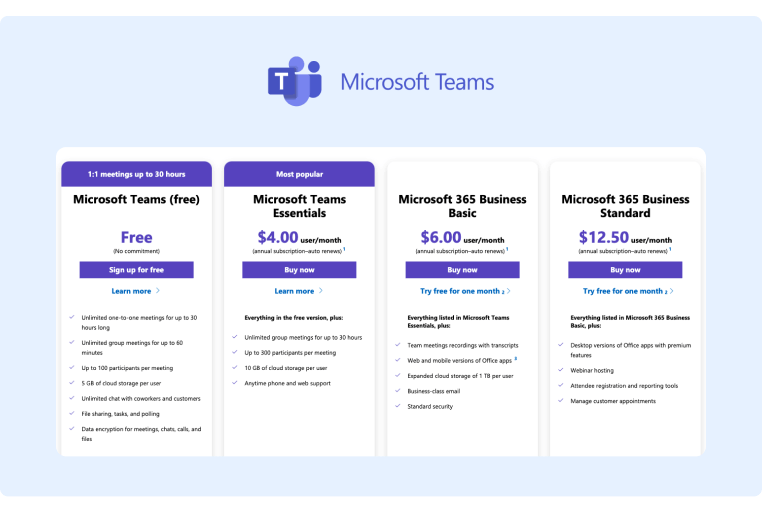
Selecting The Best Team Collaboration Tool
While there isn’t a single best team collaboration tool, this question can help you select the best team collaboration tool:
Which of these tools can help me minimize communication as much as possible?
So instead of selecting a tool that just makes messaging easier, a truly great team collaboration tool makes it possible for the team to stay aligned without actively messaging each other.
If you’re doing any kind of social media marketing, GaggleAMP is a great team collaboration tool to add to your stack. Marketing managers can easily assign activities without messaging a co-worker, and co-workers can access all the information they need to engage without messaging the marketing team.
To see for yourself if GaggleAMP is a good fit for your team, schedule a demo today or sign up for a free trial.










